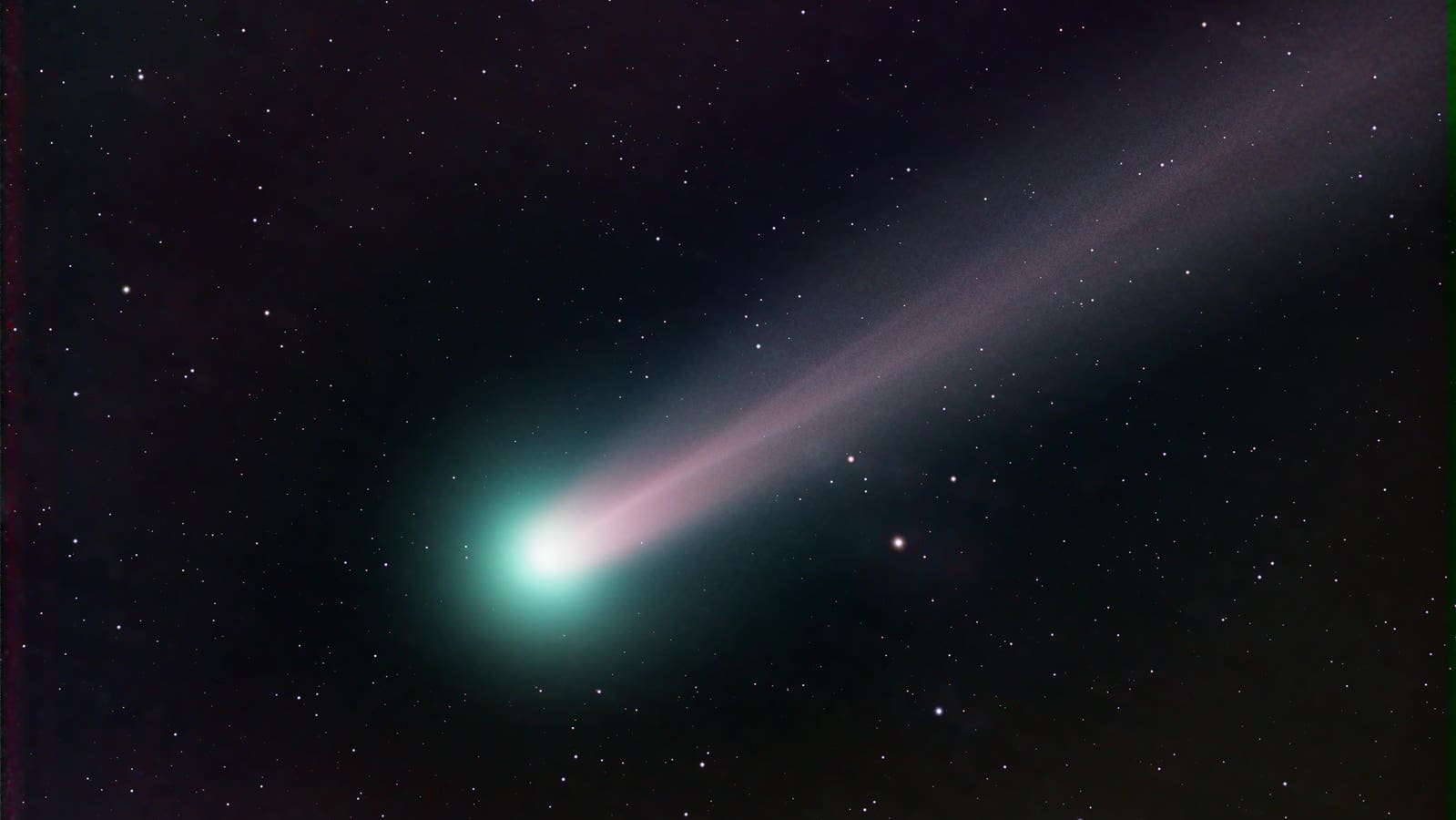Topline
A green comet continues to shine brightly after sunset for skywatchers in the Northern Hemisphere. For observers on Thursday, Oct. 23, Comet Lemmon (C/2025 A6) — also the fainter and Comet SWAN (C/2025 R2) — are relatively easy to find using binoculars. Lemmon will be above bright star Arcturus, low on the northwest horizon, and SWAN will be high in the southwest, just below the bright star Altair in the Summer Triangle. This is the last, best chance to see them because they’ll likely dim from now on, both because they’re now receding from Earth and the 5%-lit waxing crescent moon will brighten later in the week, bleaching the night sky and making the comets harder to find.
Comets Lemmon and SWAN are now becoming visible. Although they will get brighter next week, you can glimpse them now using binoculars or a telescope. (Image is of Comet Lovejoy)
GettyKey Facts
The comets are visible in the northwest (Lemmon) and southwest (SWAN) about 90 minutes after sunset. Lemmon is moving quickly across the sky west of the Big Dipper, close to bright star Arcturus, while SWAN is beneath the three bright stars that comprise the Summer Triangle. At magntitude +4.4, Lemmon is by far the brighter and easiest to see.
Observers may be able to see both comets with the naked eye, but binoculars will be required to see their tails. The best views will be had far from light pollution in a Dark Sky Place (or somewhere that looks dark on a light pollution map).
The best way to find the comets is stargazing apps such as Sky Guide, Stellarium and SkySafari, or the finder charts at In-The-Sky.com.
The moon is about to make both comets harder to see, and by the weekend, both comets are likely to have faded slightly. As always, comets can have a surprise outburst and brighten or a sudden disintegration and fade.
There’s a third headline-grabbing comet in the solar system. Though it’s much tougher to see, Comet 3I/ATLAS is special because it’s interstellar — it’s from another star system. While almost all comets loop around the sun, 3I/ATLAS has broken free of its star and is traveling at 30,000 miles (209,000 kilometers) per hour through the solar system.
How to find Comet Lemmon, 90 minutes after sunset, from Oct. 13-24, 2025.
StellariumWhen And Where To See The Comets
The best time to spot Comet Lemmon and Comet SWAN on Thursday, Oct. 23, is during a 30-minute window starting about 90 minutes after sunset where you are. Both are visible after sunset but in opposite parts of the sky — Lemmon in the northwest, SWAN in the southwest. For New York City, where sunset is at 6:00 p.m. EDT, the ideal time for evening viewing is 7:30-8:00 p.m. EDT. A 5%-lit waxing crescent moon sets early, leaving dark skies that still favor comet observation before it brightens later in the week.
Where to find Comet Lemmon after sunset on Oct. 23, 2025.
StellariumHow To Find Comet Lemmon
Distance from the sun: 60.3 million miles (97.1 million kilometers)
Distance from Earth: 56.3 million miles (90.5 million kilometers)
After sunset on Thursday, Oct. 23, look for Comet Lemmon immediately above bright star Arcturus, low on the northwest horizon. Trace the stars in the Big Dipper’s curved handle and go in an “arc to Arcturus.” Now go a couple of degrees above Arcturus to the next bright star, Izar. Comet Lemmon will be about four degrees to the right of Izar. Its height above the horizon varies by location, but from New York, the comet will appear about 20 degrees above the northwest horizon at 7:30 p.m. EDT and will gradually sink as twilight deepens.
How to find Comet Lemmon, 90 minutes after sunset, from Oct. 13-31, 2025.
StellariumHow To Find Comet Swan
Distance from the sun: 96.5 million miles (155.3 million kilometers)
Distance from Earth: 25.5 million miles (41 million kilometers)
Blueish-green Comet SWAN will be visible in binoculars on Thursday, Oct. 23, 2025, low in the south after sunset. SWAN will be in the constellation Aquila, above the famous “Teapot” asterism in the constellation Sagittarius, and directly below the bright star Altair in the Summer Triangle. The comet’s height above the horizon will vary depending on your location, but from New York, it will be around 41 degrees up as it becomes visible.
Both comets will remain visible for another few evenings, but bright moonlight will quickly begin to wash them out by the weekend.
Where to find Comet SWAN after sunset on Oct. 23, 2025.
Stellarium
Check my feed every day this month for a daily “comet tracker” with finder charts and tips for viewing Comet Lemmon and Comet SWAN from mid-northern latitudes. Also read How To Photograph The Green Comets, Best Stargazing Apps For Finding The Comets and 25 Dark Sky Parks In The U.S. To See The Comets.
Further ReadingForbesComet Tracker For Thursday: It’s Finally Time To See Rare Twin CometsBy Jamie CarterForbesA Once-In-A-Lifetime Green Comet May Soon Be Visible, Scientists SayBy Jamie CarterForbesSee Rare Sight Of Two Comets As Meteor Shower Peaks — Here’s WhenBy Jamie CarterForbesComet Lemmon: Your Ultimate Viewing Guide To The ‘Comet Of The Year’By Jamie CarterForbesTwo Naked Eye Comets, ‘Harvest Moon’ And Fireballs: October’s Night SkyBy Jamie CarterForbesOrionid Meteor Shower Begins Thursday — When To See It At Its Best With Two CometsBy Jamie CarterForbesI Just Saw And Photographed The Comet — Here’s How You Can TooBy Jamie Carter
